change wheel PORSCHE 911 TURBO 2014 6.G Owner's Guide
[x] Cancel search | Manufacturer: PORSCHE, Model Year: 2014, Model line: 911 TURBO, Model: PORSCHE 911 TURBO 2014 6.GPages: 300, PDF Size: 10.61 MB
Page 246 of 300
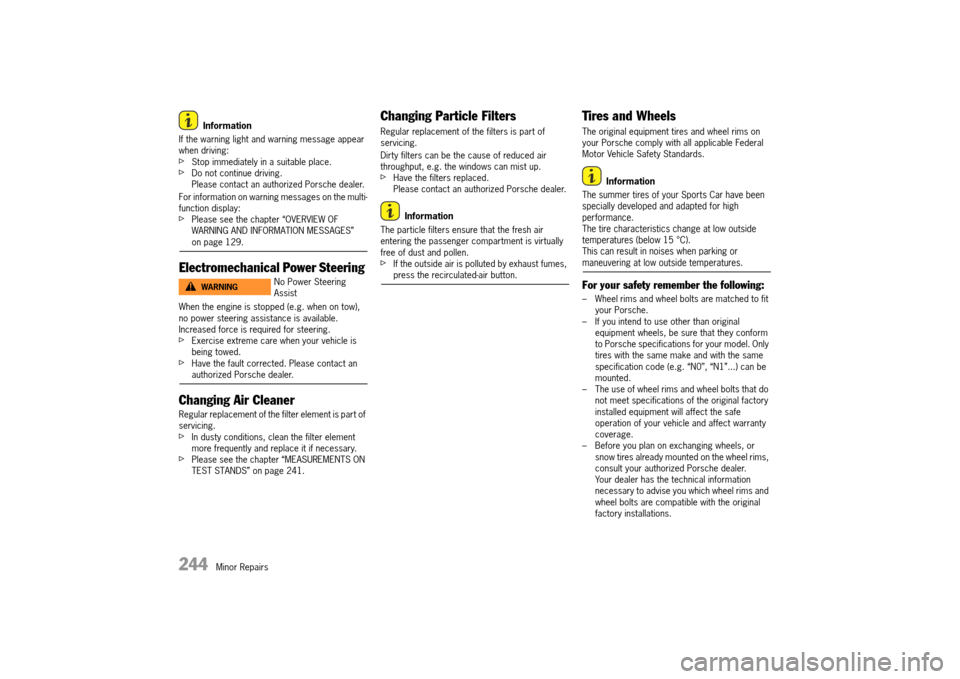
244 Minor Repairs
Information
If the warning light and warning message appear when driving: fStop immediately in a suitable place.fDo not continue driving.Please contact an authorized Porsche dealer.
For information on warning messages on the multi- function display: fPlease see the chapter “OVERVIEW OF WARNING AND INFORMATION MESSAGES” on page 129.
Electromechanical Power Steering
When the engine is stopped (e.g. when on tow), no power steering assistance is available.Increased force is required for steering.fExercise extreme care when your vehicle is being towed.fHave the fault corrected. Please contact an authorized Porsche dealer.
Changing Air Cleaner
Regular replacement of the filter element is part of servicing.fIn dusty conditions, clean the filter element more frequently and replace it if necessary.fPlease see the chapter “MEASUREMENTS ON TEST STANDS” on page 241.
Changing Particle Filters
Regular replacement of the filters is part of servicing.
Dirty filters can be the cause of reduced air throughput, e.g. the windows can mist up.fHave the filters replaced.Please contact an authorized Porsche dealer.
Information
The particle filters ensure that the fresh air entering the passenger compartment is virtually free of dust and pollen.fIf the outside air is polluted by exhaust fumes, press the recirculated-air button.
Tires and Wheels
The original equipment tires and wheel rims on your Porsche comply with all applicable Federal Motor Vehicle Safety Standards.
Information
The summer tires of your Sports Car have been specially developed and adapted for high performance.The tire characteristics change at low outside temperatures (below 15 °C).This can result in noises when parking or maneuvering at low outside temperatures.
For your safety remember the following:
– Wheel rims and wheel bolts are matched to fit your Porsche.– If you intend to use other than original equipment wheels, be sure that they conform to Porsche specifications for your model. Only tires with the same make and with the same specification code (e.g. “N0”, “N1”...) can be mounted.– The use of wheel rims and wheel bolts that do not meet specifications of the original factory installed equipment will affect the safe operation of your vehicle and affect warranty coverage.– Before you plan on exchanging wheels, or snow tires already mounted on the wheel rims, consult your authorized Porsche dealer. Your dealer has the technical information necessary to advise you which wheel rims and wheel bolts are compatible with the original factory installations.
No Power Steering AssistWARNINGh
14_991_Turbo_21.book Seite 244 Mittwoch, 9. April 2014 2:19 14
Page 251 of 300
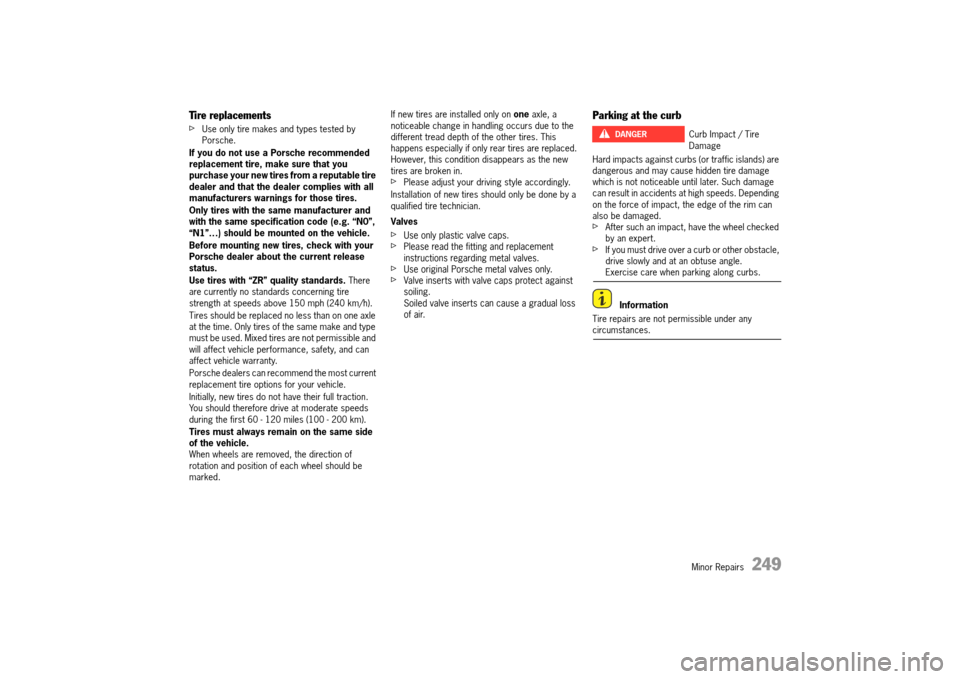
Minor Repairs 249
Tire replacements
fUse only tire makes and types tested by Porsche.
If you do not use a Porsche recommended replacement tire, make sure that you purchase your new tires from a reputable tire dealer and that the dealer complies with all manufacturers warnings for those tires.
Only tires with the same manufacturer and with the same specification code (e.g. “N0”, “N1”…) should be mounted on the vehicle.
Before mounting new tires, check with your Porsche dealer about the current release status.
Use tires with “ZR” quality standards. There are currently no standards concerning tire strength at speeds above 150 mph (240 km/h).
Tires should be replaced no less than on one axle at the time. Only tires of the same make and type must be used. Mixed tires are not permissible and will affect vehicle performance, safety, and can affect vehicle warranty.
Porsche dealers can recommend the most current replacement tire options for your vehicle.
Initially, new tires do not have their full traction. You should therefore drive at moderate speeds during the first 60 - 120 miles (100 - 200 km).
Tires must always remain on the same side of the vehicle.When wheels are removed, the direction of rotation and position of each wheel should be marked.
If new tires are installed only on one axle, a noticeable change in handling occurs due to the different tread depth of the other tires. This happens especially if only rear tires are replaced. However, this condition disappears as the new tires are broken in.fPlease adjust your driving style accordingly.
Installation of new tires should only be done by a qualified tire technician.
Valves
fUse only plastic valve caps.fPlease read the fitting and replacement instructions regarding metal valves.fUse original Porsche metal valves only.fValve inserts with valve caps protect against soiling.Soiled valve inserts can cause a gradual loss of air.
Parking at the curb
Hard impacts against curbs (or traffic islands) are dangerous and may cause hidden tire damage which is not noticeable until later. Such damage can result in accidents at high speeds. Depending on the force of impact, the edge of the rim can also be damaged.fAfter such an impact, have the wheel checked by an expert.fIf you must drive over a curb or other obstacle, drive slowly and at an obtuse angle. Exercise care when parking along curbs.
Information
Tire repairs are not permissible under any circumstances.
Curb Impact / Tire Damage
DANGERh
14_991_Turbo_21.book Seite 249 Mittwoch, 9. April 2014 2:19 14
Page 252 of 300
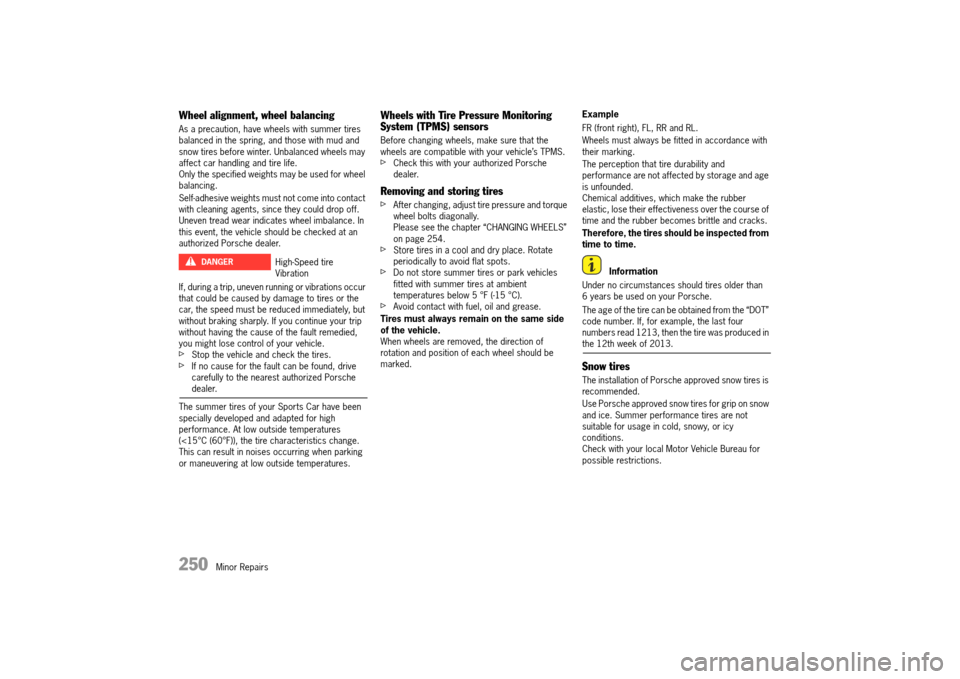
250 Minor Repairs
Wheel alignment, wheel balancing
As a precaution, have wheels with summer tires balanced in the spring, and those with mud and snow tires before winter. Unbalanced wheels may affect car handling and tire life.Only the specified weights may be used for wheel balancing.
Self-adhesive weights must not come into contact with cleaning agents, since they could drop off.Uneven tread wear indicates wheel imbalance. In this event, the vehicle should be checked at an authorized Porsche dealer.
If, during a trip, uneven running or vibrations occur that could be caused by damage to tires or the car, the speed must be reduced immediately, but without braking sharply. If you continue your trip without having the cause of the fault remedied, you might lose control of your vehicle.fStop the vehicle and check the tires.fIf no cause for the fault can be found, drive carefully to the nearest authorized Porsche dealer.
The summer tires of your Sports Car have been specially developed and adapted for high performance. At low outside temperatures (<15°C (60°F)), the tire characteristics change. This can result in noises occurring when parking or maneuvering at low outside temperatures.
Wheels with Tire Pressure Monitoring System (TPMS) sensors
Before changing wheels, make sure that the wheels are compatible with your vehicle’s TPMS.fCheck this with your authorized Porsche dealer.
Removing and storing tires
fAfter changing, adjust tire pressure and torque wheel bolts diagonally. Please see the chapter “CHANGING WHEELS” on page 254.fStore tires in a cool and dry place. Rotate periodically to avoid flat spots.fDo not store summer tires or park vehicles fitted with summer tires at ambient temperatures below 5 °F (-15 °C).fAvoid contact with fuel, oil and grease.
Tires must always remain on the same side of the vehicle.When wheels are removed, the direction of rotation and position of each wheel should be marked.
Example
FR (front right), FL, RR and RL.
Wheels must always be fitted in accordance with their marking.
The perception that tire durability and performance are not affected by storage and age is unfounded. Chemical additives, which make the rubber elastic, lose their effectiveness over the course of time and the rubber becomes brittle and cracks.
Therefore, the tires should be inspected from time to time.
Information
Under no circumstances should tires older than 6 years be used on your Porsche.
The age of the tire can be obtained from the “DOT” code number. If, for example, the last four numbers read 1213, then the tire was produced in the 12th week of 2013.
Snow tires
The installation of Porsche approved snow tires is recommended.
Use Porsche approved snow tires for grip on snow and ice. Summer performance tires are not suitable for usage in cold, snowy, or icy conditions.Check with your local Motor Vehicle Bureau for possible restrictions.
High-Speed tire Vibration
DANGERh
14_991_Turbo_21.book Seite 250 Mittwoch, 9. April 2014 2:19 14
Page 253 of 300
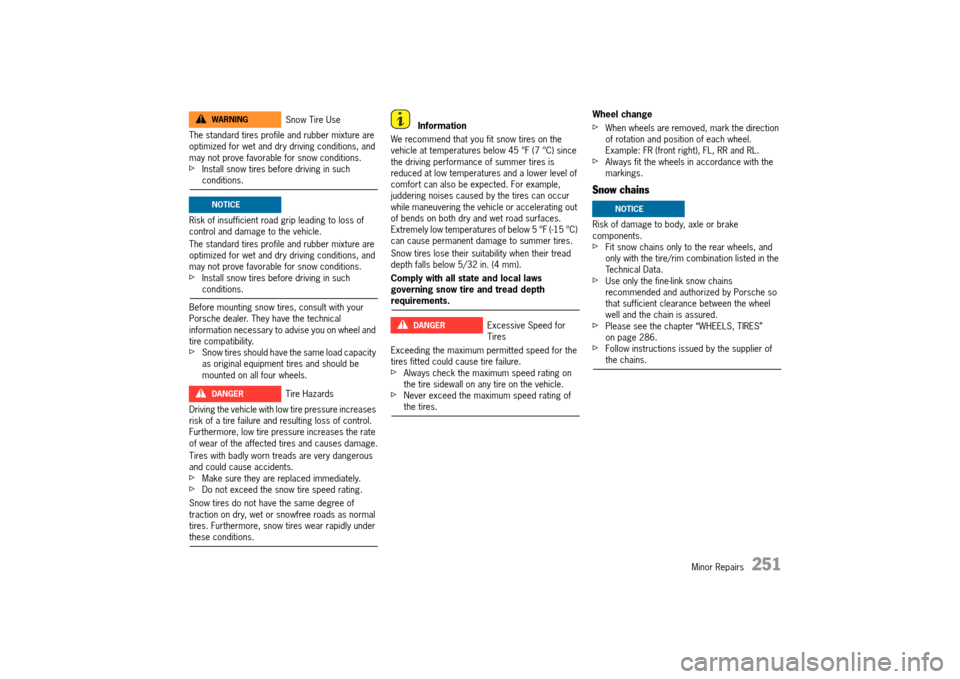
Minor Repairs 251
The standard tires profile and rubber mixture are optimized for wet and dry driving conditions, and may not prove favorable for snow conditions.fInstall snow tires before driving in such conditions.
Risk of insufficient road grip leading to loss of control and damage to the vehicle.
The standard tires profile and rubber mixture are optimized for wet and dry driving conditions, and may not prove favorable for snow conditions.fInstall snow tires before driving in such conditions.
Before mounting snow tires, consult with your Porsche dealer. They have the technical information necessary to advise you on wheel and tire compatibility.fSnow tires should have the same load capacity as original equipment tires and should be mounted on all four wheels.
Driving the vehicle with low tire pressure increases risk of a tire failure and resulting loss of control. Furthermore, low tire pressure increases the rate of wear of the affected tires and causes damage.
Tires with badly worn treads are very dangerous and could cause accidents.fMake sure they are replaced immediately.fDo not exceed the snow tire speed rating.
Snow tires do not have the same degree of traction on dry, wet or snowfree roads as normal tires. Furthermore, snow tires wear rapidly under these conditions.
Information
We recommend that you fit snow tires on the vehicle at temperatures below 45 °F (7 °C) since the driving performance of summer tires is reduced at low temperatures and a lower level of comfort can also be expected. For example, juddering noises caused by the tires can occur while maneuvering the vehicle or accelerating out of bends on both dry and wet road surfaces.Extremely low temperatures of below 5 °F (-15 °C) can cause permanent damage to summer tires.
Snow tires lose their suitability when their tread depth falls below 5/32 in. (4 mm).
Comply with all state and local laws governing snow tire and tread depth requirements.
Exceeding the maximum permitted speed for the tires fitted could cause tire failure.fAlways check the maximum speed rating on the tire sidewall on any tire on the vehicle.fNever exceed the maximum speed rating of the tires.
Wheel change
fWhen wheels are removed, mark the direction of rotation and position of each wheel.Example: FR (front right), FL, RR and RL.fAlways fit the wheels in accordance with the markings.
Snow chains
Risk of damage to body, axle or brake components.fFit snow chains only to the rear wheels, and only with the tire/rim combination listed in the Technical Data.fUse only the fine-link snow chains recommended and authorized by Porsche so that sufficient clearance between the wheel well and the chain is assured.fPlease see the chapter “WHEELS, TIRES” on page 286.fFollow instructions issued by the supplier of the chains.
Snow Tire Use
Tire Hazards
WARNINGh
NOTICE
DANGERh
Excessive Speed for Tires
DANGERh
NOTICE
14_991_Turbo_21.book Seite 251 Mittwoch, 9. April 2014 2:19 14
Page 256 of 300
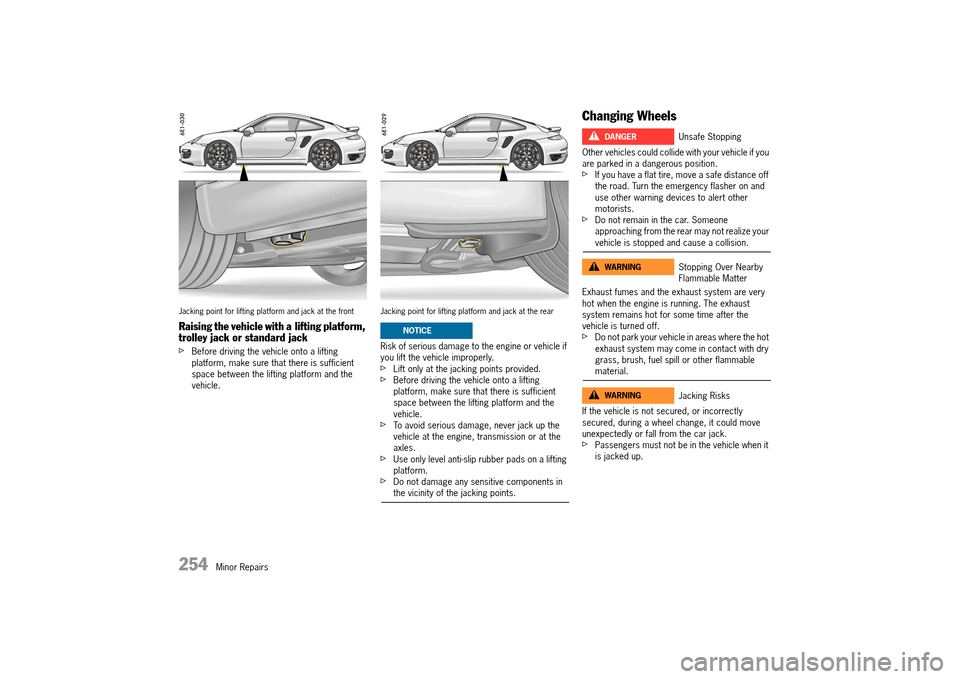
254 Minor Repairs
Jacking point for lifting platform and jack at the front
Raising the vehicle with a lifting platform, trolley jack or standard jack
fBefore driving the vehicle onto a lifting platform, make sure that there is sufficient space between the lifting platform and the vehicle.
Jacking point for lifting platform and jack at the rear
Risk of serious damage to the engine or vehicle if you lift the vehicle improperly.fLift only at the jacking points provided.fBefore driving the vehicle onto a lifting platform, make sure that there is sufficient space between the lifting platform and the vehicle.fTo avoid serious damage, never jack up the vehicle at the engine, transmission or at the axles.fUse only level anti-slip rubber pads on a lifting platform.fDo not damage any sensitive components in the vicinity of the jacking points.
Changing Wheels
Other vehicles could collide with your vehicle if you are parked in a dangerous position.fIf you have a flat tire, move a safe distance off the road. Turn the emergency flasher on and use other warning devices to alert other motorists.fDo not remain in the car. Someone approaching from the rear may not realize your vehicle is stopped and cause a collision.
Exhaust fumes and the exhaust system are very hot when the engine is running. The exhaust system remains hot for some time after the vehicle is turned off.fDo not park your vehicle in areas where the hot exhaust system may come in contact with dry grass, brush, fuel spill or other flammable material.
If the vehicle is not secured, or incorrectly secured, during a wheel change, it could move unexpectedly or fall from the car jack.fPassengers must not be in the vehicle when it is jacked up.
NOTICE
Unsafe Stopping
Stopping Over Nearby Flammable Matter
Jacking Risks
DANGERh
WARNINGh
WARNINGh
14_991_Turbo_21.book Seite 254 Mittwoch, 9. April 2014 2:19 14
Page 257 of 300
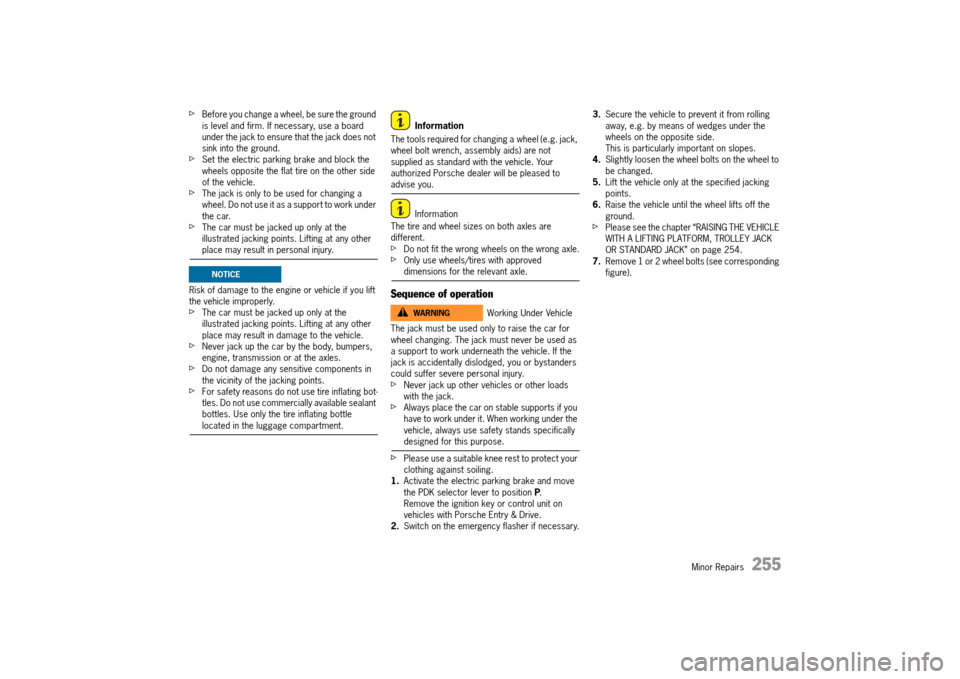
Minor Repairs 255
fBefore you change a wheel, be sure the ground is level and firm. If necessary, use a board under the jack to ensure that the jack does not sink into the ground.fSet the electric parking brake and block the wheels opposite the flat tire on the other side of the vehicle.fThe jack is only to be used for changing a wheel. Do not use it as a support to work under the car.fThe car must be jacked up only at the illustrated jacking points. Lifting at any other place may result in personal injury.
Risk of damage to the engine or vehicle if you lift the vehicle improperly.fThe car must be jacked up only at the illustrated jacking points. Lifting at any other place may result in damage to the vehicle.fNever jack up the car by the body, bumpers, engine, transmission or at the axles.fDo not damage any sensitive components in the vicinity of the jacking points.fFor safety reasons do not use tire inflating bot-tles. Do not use commercially available sealant bottles. Use only the tire inflating bottle located in the luggage compartment.
Information
The tools required for changing a wheel (e.g. jack, wheel bolt wrench, assembly aids) are not supplied as standard with the vehicle. Your authorized Porsche dealer will be pleased to advise you.
Information
The tire and wheel sizes on both axles are different.fDo not fit the wrong wheels on the wrong axle.fOnly use wheels/tires with approved dimensions for the relevant axle.
Sequence of operation
The jack must be used only to raise the car for wheel changing. The jack must never be used as a support to work underneath the vehicle. If the jack is accidentally dislodged, you or bystanders could suffer severe personal injury.fNever jack up other vehicles or other loads with the jack.fAlways place the car on stable supports if you have to work under it. When working under the vehicle, always use safety stands specifically designed for this purpose.
fPlease use a suitable knee rest to protect your clothing against soiling.1. Activate the electric parking brake and move the PDK selector lever to position P. Remove the ignition key or control unit on vehicles with Porsche Entry & Drive.2. Switch on the emergency flasher if necessary.
3. Secure the vehicle to prevent it from rolling away, e.g. by means of wedges under the wheels on the opposite side.This is particularly important on slopes.4. Slightly loosen the wheel bolts on the wheel to be changed.5. Lift the vehicle only at the specified jacking points.6. Raise the vehicle until the wheel lifts off the ground. fPlease see the chapter “RAISING THE VEHICLE WITH A LIFTING PLATFORM, TROLLEY JACK OR STANDARD JACK” on page 254.7. Remove 1 or 2 wheel bolts (see corresponding figure).NOTICE
Working Under VehicleWARNINGh
14_991_Turbo_21.book Seite 255 Mittwoch, 9. April 2014 2:19 14
Page 258 of 300
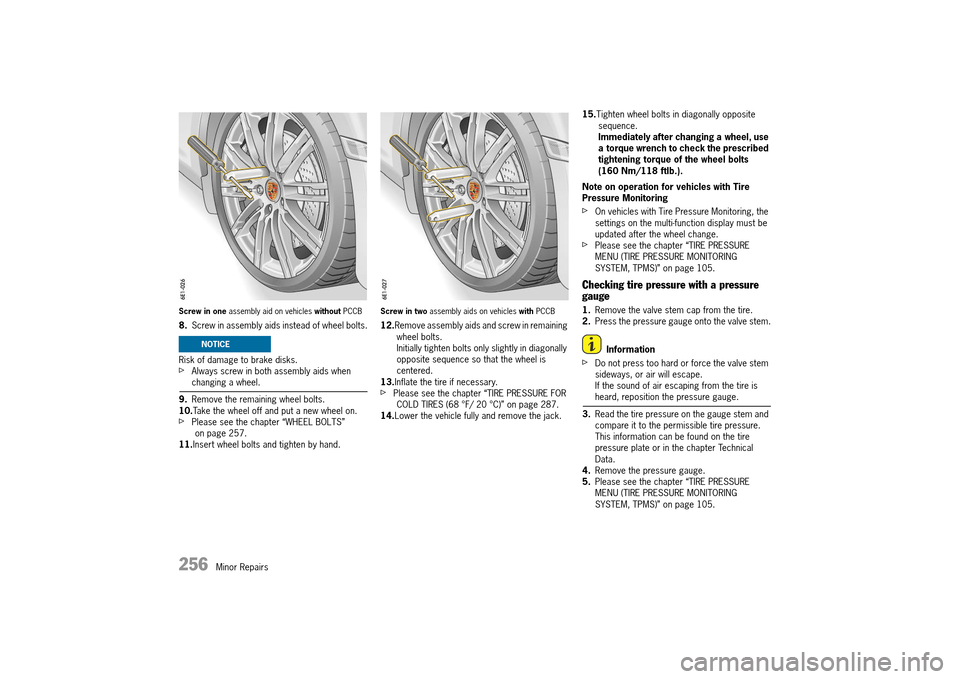
256 Minor Repairs
Screw in one assembly aid on vehicles without PCCB
8.Screw in assembly aids instead of wheel bolts.
Risk of damage to brake disks.fAlways screw in both assembly aids when changing a wheel.
9. Remove the remaining wheel bolts. 10. Take the wheel off and put a new wheel on.fPlease see the chapter “WHEEL BOLTS” on page 257.11. Insert wheel bolts and tighten by hand.
Screw in two assembly aids on vehicles with PCCB
12.Remove assembly aids and screw in remaining wheel bolts.Initially tighten bolts only slightly in diagonally opposite sequence so that the wheel is centered.13. Inflate the tire if necessary.fPlease see the chapter “TIRE PRESSURE FOR COLD TIRES (68 °F/ 20 °C)” on page 287.14. Lower the vehicle fully and remove the jack.
15. Tighten wheel bolts in diagonally opposite sequence.Immediately after changing a wheel, use a torque wrench to check the prescribed tightening torque of the wheel bolts (160 Nm/118 ftlb.).
Note on operation for vehicles with Tire Pressure Monitoring
fOn vehicles with Tire Pressure Monitoring, the settings on the multi-function display must be updated after the wheel change.fPlease see the chapter “TIRE PRESSURE MENU (TIRE PRESSURE MONITORING SYSTEM, TPMS)” on page 105.
Checking tire pressure with a pressure gauge
1. Remove the valve stem cap from the tire. 2. Press the pressure gauge onto the valve stem.
Information
fDo not press too hard or force the valve stem sideways, or air will escape.If the sound of air escaping from the tire is heard, reposition the pressure gauge.
3. Read the tire pressure on the gauge stem and compare it to the permissible tire pressure.This information can be found on the tire pressure plate or in the chapter Technical Data.4. Remove the pressure gauge. 5. Please see the chapter “TIRE PRESSURE MENU (TIRE PRESSURE MONITORING SYSTEM, TPMS)” on page 105.
NOTICE
14_991_Turbo_21.book Seite 256 Mittwoch, 9. April 2014 2:19 14
Page 260 of 300
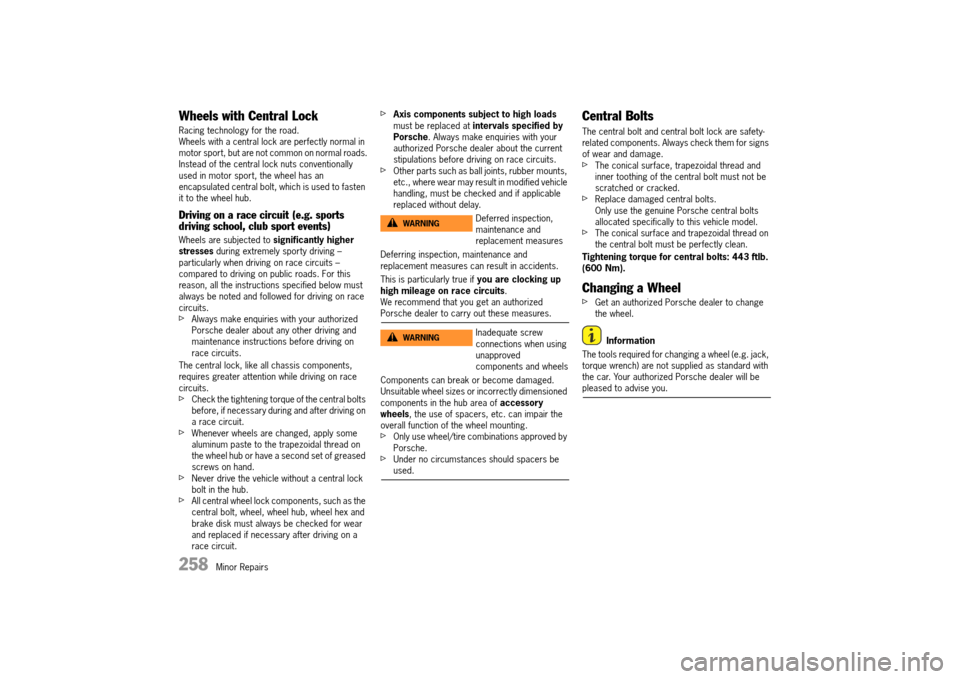
258 Minor Repairs
Wheels with Central Lock
Racing technology for the road. Wheels with a central lock are perfectly normal in motor sport, but are not common on normal roads.Instead of the central lock nuts conventionally used in motor sport, the wheel has an encapsulated central bolt, which is used to fasten it to the wheel hub.
Driving on a race circuit (e.g. sports driving school, club sport events)
Wheels are subjected to significantly higher stresses during extremely sporty driving – particularly when driving on race circuits – compared to driving on public roads. For this reason, all the instructions specified below must always be noted and followed for driving on race circuits.fAlways make enquiries with your authorized Porsche dealer about any other driving and maintenance instructions before driving on race circuits.
The central lock, like all chassis components, requires greater attention while driving on race circuits.fCheck the tightening torque of the central bolts before, if necessary during and after driving on a race circuit.fWhenever wheels are changed, apply some aluminum paste to the trapezoidal thread on the wheel hub or have a second set of greased screws on hand.fNever drive the vehicle without a central lock bolt in the hub.fAll central wheel lock components, such as the central bolt, wheel, wheel hub, wheel hex and brake disk must always be checked for wear and replaced if necessary after driving on a race circuit.
fAxis components subject to high loads must be replaced at intervals specified by Porsche . Always make enquiries with your authorized Porsche dealer about the current stipulations before driving on race circuits.fOther parts such as ball joints, rubber mounts, etc., where wear may result in modified vehicle handling, must be checked and if applicable replaced without delay.
Deferring inspection, maintenance and replacement measures can result in accidents.
This is particularly true if you are clocking up high mileage on race circuits . We recommend that you get an authorized Porsche dealer to carry out these measures.
Components can break or become damaged. Unsuitable wheel sizes or incorrectly dimensioned components in the hub area of accessory wheels , the use of spacers, etc. can impair the overall function of the wheel mounting.fOnly use wheel/tire combinations approved by Porsche.fUnder no circumstances should spacers be used.
Central Bolts
The central bolt and central bolt lock are safety-related components. Always check them for signs of wear and damage.fThe conical surface, trapezoidal thread and inner toothing of the central bolt must not be scratched or cracked.fReplace damaged central bolts.Only use the genuine Porsche central bolts allocated specifically to this vehicle model.fThe conical surface and trapezoidal thread on the central bolt must be perfectly clean.
Tightening torque for central bolts: 443 ftlb. (600 Nm).
Changing a Wheel
fGet an authorized Porsche dealer to change the wheel.
Information
The tools required for changing a wheel (e.g. jack, torque wrench) are not supplied as standard with the car. Your authorized Porsche dealer will be pleased to advise you.
Deferred inspection, maintenance and replacement measures
Inadequate screw connections when using unapproved components and wheels
WARNINGh
WARNINGh
14_991_Turbo_21.book Seite 258 Mittwoch, 9. April 2014 2:19 14
Page 261 of 300
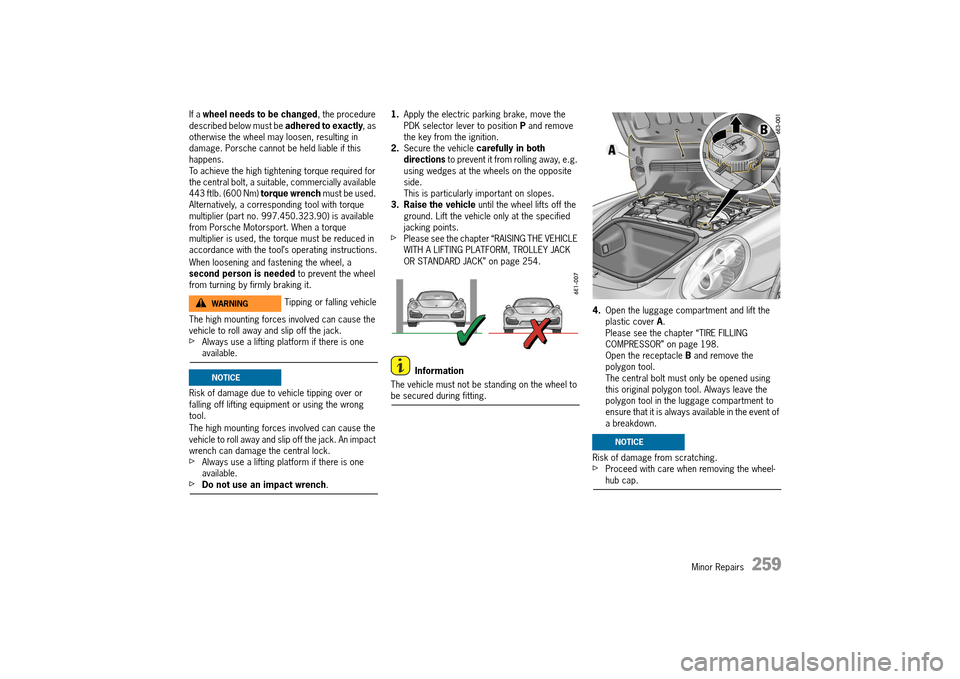
Minor Repairs 259
If a wheel needs to be changed, the procedure described below must be adhered to exactly, as otherwise the wheel may loosen, resulting in damage. Porsche cannot be held liable if this happens.To achieve the high tightening torque required for the central bolt, a suitable, commercially available 443 ftlb. (600 Nm) torque wrench must be used. Alternatively, a corresponding tool with torque multiplier (part no. 997.450.323.90) is available from Porsche Motorsport. When a torque multiplier is used, the torque must be reduced in accordance with the tool’s operating instructions.
When loosening and fastening the wheel, a second person is needed to prevent the wheel from turning by firmly braking it.
The high mounting forces involved can cause the vehicle to roll away and slip off the jack.fAlways use a lifting platform if there is one available.
Risk of damage due to vehicle tipping over or falling off lifting equipment or using the wrong tool.
The high mounting forces involved can cause the vehicle to roll away and slip off the jack. An impact wrench can damage the central lock.fAlways use a lifting platform if there is one available.fDo not use an impact wrench .
1. Apply the electric parking brake, move the PDK selector lever to position P and remove the key from the ignition.2. Secure the vehicle carefully in both directions to prevent it from rolling away, e.g. using wedges at the wheels on the opposite side.This is particularly important on slopes.3. Raise the vehicle until the wheel lifts off the ground. Lift the vehicle only at the specified jacking points.fPlease see the chapter “RAISING THE VEHICLE WITH A LIFTING PLATFORM, TROLLEY JACK OR STANDARD JACK” on page 254.
Information
The vehicle must not be standing on the wheel to be secured during fitting.
4. Open the luggage compartment and lift the plastic cover A. Please see the chapter “TIRE FILLING COMPRESSOR” on page 198.Open the receptacle B and remove the polygon tool.The central bolt must only be opened using this original polygon tool. Always leave the polygon tool in the luggage compartment to ensure that it is always available in the event of a breakdown.
Risk of damage from scratching.fProceed with care when removing the wheel-hub cap.
Tipping or falling vehicleWARNINGh
NOTICE
NOTICE
14_991_Turbo_21.book Seite 259 Mittwoch, 9. April 2014 2:19 14
Page 263 of 300
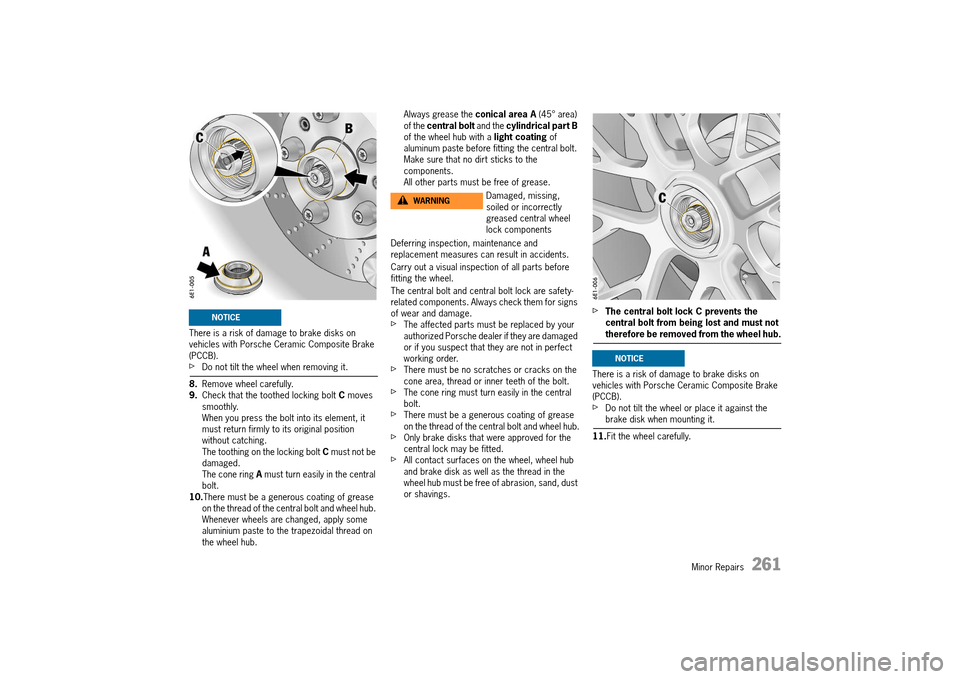
Minor Repairs 261
There is a risk of damage to brake disks on vehicles with Porsche Ceramic Composite Brake (PCCB).fDo not tilt the wheel when removing it.
8. Remove wheel carefully. 9. Check that the toothed locking bolt C moves smoothly.When you press the bolt into its element, it must return firmly to its original position without catching.The toothing on the locking bolt C must not be damaged.The cone ring A must turn easily in the central bolt.10. There must be a generous coating of grease on the thread of the central bolt and wheel hub. Whenever wheels are changed, apply some aluminium paste to the trapezoidal thread on the wheel hub.
Always grease the conical area A (45° area) of the central bolt and the cylindrical part B of the wheel hub with a light coating of aluminum paste before fitting the central bolt. Make sure that no dirt sticks to the components.All other parts must be free of grease.
Deferring inspection, maintenance and replacement measures can result in accidents.
Carry out a visual inspection of all parts before fitting the wheel.
The central bolt and central bolt lock are safety- related components. Always check them for signs of wear and damage.fThe affected parts must be replaced by your authorized Porsche dealer if they are damaged or if you suspect that they are not in perfect working order.fThere must be no scratches or cracks on the cone area, thread or inner teeth of the bolt.fThe cone ring must turn easily in the central bolt.fThere must be a generous coating of grease on the thread of the central bolt and wheel hub.fOnly brake disks that were approved for the central lock may be fitted.fAll contact surfaces on the wheel, wheel hub and brake disk as well as the thread in the wheel hub must be free of abrasion, sand, dust or shavings.
fThe central bolt lock C prevents the central bolt from being lost and must not therefore be removed from the wheel hub.
There is a risk of damage to brake disks on vehicles with Porsche Ceramic Composite Brake (PCCB).fDo not tilt the wheel or place it against the brake disk when mounting it.
11. Fit the wheel carefully.
NOTICE
Damaged, missing, soiled or incorrectly greased central wheel lock components
WARNINGh
NOTICE
14_991_Turbo_21.book Seite 261 Mittwoch, 9. April 2014 2:19 14